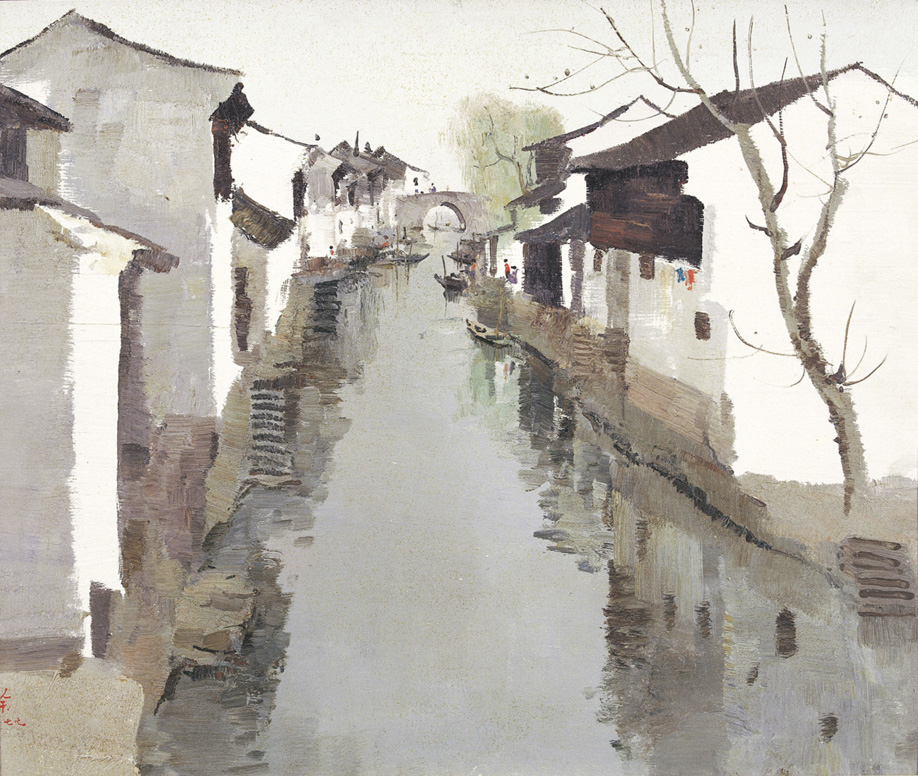Born in 1919, Wu Guanzhong grew up in hometown Yixing, Jiangsu. He is the first living Eastern artist who ever held a solo exhibition in the British Museum. Being a native of Southern China, he loves the landscape in his hometown. In 1978, the Lu Xun Museum invited Wu Guanzhong to paint a huge painting of Lu Xun's hometown. Wu has been respect Lu Xun in all his life. During one interview, he mentioned: "China could do without Qi Baishi, but couldn't do without Lu Xun." Lu Xun's influence in Chinese history is tremendous. "Without Lu Xun, I would never do art. Without Lu Xun, today's Wu Guangzohng would never exist." Wu said1.
As he respected Lu Xun and cared for his hometown, and Yixing was so similar to Shaoxing, Wu's birthplace; therefore, he traveled down south, going to Shaoxing, Zhejiang province to do his sketches. Next year, he completed the huge scale oil painting of Lu Xun's Old Home, which was collected permanently by the Lu Xun Museum in Beijing. According to Wu Guanzhong, it was not the first time he ever sketched in Shaoxing. Before this project he went to Shaoxing twice for the sake of painting. The first time was in 1956; he lived in the en suite of Lu Xun's old home. The second occasion was in 1977; he backpacked with his painting gear and traveled all over the small town, bridges, streams, and homes in Shaoxing. All the landscapes in Southern China were attractive to him.
Lu Xun (1881-1936), a native of Shaoxing, Zhejiang province, is a famous modern Chinese writer. His literature, philosophy, and woodcuts enjoy high acclaim in the literary and cultural circles of China. In 1919, when he returned to his long left home, he wrote the novel My Old Home. In Lu Xun's My Old Home, he depicts that after leaving his hometown for 20 years, to a place some two thousand miles away, he begins to feel strange about the black tiles and white walls, bamboo and plants, which remain unchanged. Perhaps it is a twist in his mind and heart, and he feels melancholic. Wu Guangzhong also had a feeling of empathy.
In Three Gorges on Yangtze River and Lu Xun's Home Town - Memoirs of Creation, Wu Guanzhong delineates the process of portraying the landscapes in Lu Xun's hometown. After considering the choices of the sites and scenes, and sketching several times, he finally decides the manner of depicting the landscapes in Jiangnan. He says, "... I do not like the scene of woods and paths that invite people to take walk. It is a paradox between a prose poem and a one-act play. Different from the beauty of prose, it is inconsiderable to lack overt images - to play the main role in the pictorial space. Concerning the rise and fall, and unrestrained feelings of the images, a single picture is close to a one-act play, in which the climax keeps coming2."
The lot Lu Xun's Old Home by Wu Guangzhong can be regarded as a study of the huge piece of the collection of Lu Xun Museum. Wu Guanzhong painted for Lu Xun Museum. In the foreground, a stream, an old three and dwelling houses became the leading roles. The artist arranged them with green threes, small bridge and boats in the background to compose a simple but graceful rhythm of Jiangnan.
1 Zhang Yi, 'The Master Painter's Literary Lover,' Guangming Daily, February 12, 2004
2 Wu Guanzhong. 'Zhangjiang Sanxia and Lu Xun's Home Town - Memoirs of Creation', I Want Art Not Life. Chen Ruixien, ed. Taipei: Vista Publishing Co, 1997, p. 39
